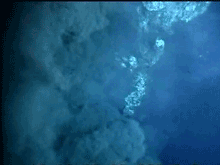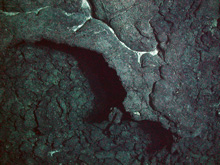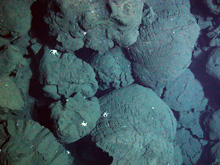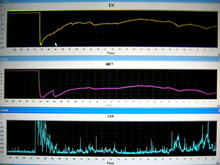
On December 11, as the DSL 120 was towed at 120 m above ridge crest near 92ºW , the oxygen, methane, Fe, Mn, and particle sensors on the DSL 120 sled and clump weight simultaneously experienced the very large signals shown above as the sensors passed through the plume of a black smoker. Click image for larger view and image credit.
Discovery of "Black Smoker" Chimneys
December 14, 2005
Rachel M. Haymon
Chief Scientist and Lead PI
The first warm springs to be found on the mid-ocean ridge were discovered in 1977 on the Galapagos Spreading Center, east of our current survey area, near 86ºW. These springs had astonishing communities of animals around them, but they were weakly-flowing vents emitting room-temperature fluids into the frigid surrounding bottom waters. Later, in 1979, scalding “black smokers” blasting from the seafloor were discovered elsewhere on the global mid-ocean ridge. Since 1977, additional exploration of the eastern Galapagos Spreading Center located a few more diffuse vents populated by animals, but did not succeed in finding any black smokers. Some scientists suggested that the influence of the Galapagos hotspot on the Galapagos Spreading Center may inhibit formation of cracks required to provide deep, hot fluid pathways for black smokers, making smokers rare and hard to find.
On the GalAPAGoS expedition, we are testing this hypothesis by searching along the crest of the Galapagos Spreading Center for the chemical and light-scattering signals of black smoker plumes. Prior to the expedition, we thought that one of the places where we might see black smokers would be where the ridge crest is broad, shallow, and lies above a magma chamber previously detected by multichannel seismic imaging at depths of only 1400- 2500 m beneath the seafloor. On December 11, as the DSL 120 was towed at 120 m above the shallow stretch of ridge crest near 92ºW, the oxygen, methane, Fe, Mn, and particle sensors on the DSL 120 sled and clump weight simultaneously experienced very large signals as they passed through the plume of a black smoker. We were very excited by this event, and could hardly wait to go back and visually hunt for the smokers on the seabed. At the end of the DSL 120 line on December 13, the DSL technicians removed the sonar sled from the cable, and replaced it with the Medea camera sled. Meanwhile, near the site where the plume was detected, we collected some plume water samples with a Niskin bottle cast. The strong rotten-egg smell of hydrogen sulfide emitted by the water samples indicated that we had sampled the plume near its source. We put the Medea close to the bottom for a look-see on the evening of December 13.
Although we know where the chemical signal from the plume is strong, this does not tell us the seafloor location of the plume source. Plumes are blown away from vents on the seafloor by bottom currents and tidal flows, and can drift thousands of meters from their seafloor source over the course of a day. The field of view illuminated by Medea’s cameras is only about the size of your living room floor, and Medea must be towed across the seafloor very slowly, more slowly than you can walk. Therefore, it can be very challenging to cover enough territory visually to locate a vent on the seafloor. It is a bit like walking slowly through the forest at night with a small flashlight, looking for mushrooms. It is necessary to use our knowledge of the typical geologic setting of ridge crest vents, and the excellent fine-scale bathymetry and backscatter images we have collected with the DSL 120, to narrow the search to the most likely areas where the smokers might be.
On the night of December 13, we first lower Medea into a trough on the ridge crest, thinking that the vent might be along a fissure on the floor of a collapsed lava pond. On this lowering of Medea, the altimeter, which detects the depth of the seafloor beneath the sled, fails to function. In the few brief minutes that the video camera transmits pictures, before the DSL techs bring Medea back aboard to replace the altimeter, I see that lava flows in the floor of the fissure are older flows on which some light-colored carbonate sediment has accumulated. I do not see any animals, and the oxygen and light-scattering sensors on Medea do not show any plume signal. I decide to try a different spot for the second lowering.
When we send Medea back down during the early hours of December 14, it is to the top of an elongated, E-W-oriented “axial volcanic ridge” (AVR) located just south of the lava pond where we put Medea on the first lowering. On the second lowering, we tow Medea slowly along this elongated volcanic construction, following a fissure along the top. The lava flows on the AVR top exhibit little carbonate sediment accumulation on the rock surfaces, and look considerably younger than the flows in the deeper trough to the north. These younger AVR flows might lie above rocks that are still hot. On the AVR top, we see more biota than previously, especially near the fissure along the ridge top. Animals are attracted to food sources at hydrothermal vents, therefore we are encouraged by these hopeful signs. We continue to search slightly downslope from the fissure, on the south slope of the AVR. I notice that the lavas there appear to be coated with brown sediment, despite being young with little carbonate sediment on them. From my previous experience diving around black smokers, I recognize the brown sediment to be fine-grained iron oxide particles that fall out of black smoker plumes. This fallout is only observed on lavas very close to a black smoker source, so we mark the position on our map and continue our traverse into the trough on the south side of the AVR.

The calcium carbonate shells of tiny sea creatures living at the sea surface fall to the seafloor as light-colored sediment when these organisms die. As time passes, this sediment accumulates on the surfaces of the volcanic rocks far below (see photo above). Click image for larger view and image credit.

The lava flows in the photo above are young, because they show little accumulation of sediment. However, these lava flows appear to be coated with fine brown mud. This brown sediment is particulate iron oxide minerals that have fallen out of the plume of a nearby black smoker. Searching near this location led to discovery of the smokers. Click image for larger view and image credit.
Like the northern trough, the southern trough is floored with older lava on which no animals are seen. Scott White and I decide to abandon the trough and tow Medea back to the top of the AVR. We travel along the axial fissure back toward the area of coated lava flows. More animals appear, and cloudy water emerges from the fissure. We know we must be close…. the lavas begin to look coated with brown sediment, and wisps of smoke drift into view. Then the smoke becomes thicker. Casey Agee, our Medea winch operator, uses thrusters on Medea to swing the vehicle from side-to-side, looking for the smoker. Then, in the forward looking video camera, we see the black smoker chimney! In just three and a half hours after lowering Medea back down to the seafloor, we have sleuthed our way to the first black smoker ever to be found on the Galapagos Spreading Center! We name this smoker “Plumeria” (after the tropical flower by that name), and continue our search along and near the axial fissure. Soon we come upon a cluster of at least six 12-14 m high chimneys pouring out massive quantities of black smoke. We name these smokers the “Iguanas” vents, after the famous marine iguanas of the Galapagos Islands.
On the morning of December 14, tired but joyful with discovery, we bring Medea back aboard. Our success in finding the smokers came from piecing together all the clues from plume sensors, water samples, seafloor bathymetry, and video images of biota and seafloor terrain. Locating the smokers relied on decades of collective vent-hunting experience among the science team, and on the technical skills of the DSL group and ship’s crew. Almost 30 years after vents were first found on the Galapagos Spreading Center, we are finally able to show that black smokers do exist here! We hope to find more black smokers, and to image the animals associated with them, as our expedition continues.
Fast FactDid you know that black smoker hydrothermal vents emit both light and sound that are beyond the ranges detectable by unaided human eyes and ears?
Sign up for the Ocean Explorer E-mail Update List.





























